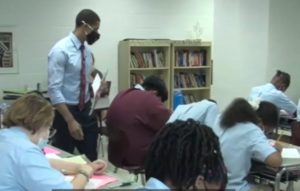12.14.21A Keystone Video: Watching Hasan Clayton Start Class

Just before a rich conversation…
One of the key changes in the 3.0 version of TLAC is the inclusion of Keystone Videos – longer more complex videos that illustrate how teachers combine and decide among techniques.
We see great value in Keystone videos to support not just better teaching generally but better execution of curriculum—including our own Reading Reconsidered Curriculum, so we wanted to share this new “Keystone” of Hasan Clayton from Nashville Classical Charter School with all teachers- and our Reading Reconsidered curriculum users especially.
Clayton.DoNow.Review from TLAC Blog on Vimeo.
In this clip you’ll see Hasan start class in his post-pandemic classroom with a Do Now and discussion in preparation for the day’s reading of To Kill A Mockingbird. Throughout the clip Hasan makes a series of decisions that create a Strong Start to class. And for our curriculum users, you may also notice how his incredibly strong pacing (not rushed but focused) sets the stage for reading success.
How to improve pacing is a question we get a lot with our reading curriculum. It is the mountain both new and experienced teachers often struggle to climb in a knowledge rich lesson. So much to do; so little time.
As soon as his 8th graders are seated, Hasan wastes no time sending students into Silent Solo work with a simple “You got this. Get busy,” followed by a scan from the corner to check that all students have started. With his timer running, he walks the aisles with minimal narration, allowing the students to stay focused on the task in front of them.
It struck us that there are four actions he uses to build his routine & be able to assign independent written work knowing that students will engage in it fully, with energy, starting right away & working for a sustained period of time.
The four actions are
- Encourage. As in, “You got this” and “Can’t wait to see those answers.”
- Appreciate. As when he reads a student’s answer and tells her “Ooh I like this idea” or “good thinking here”… or even the praise he gives X for using the aristocrat.
- Tacit Accountability. As when he watches carefully and makes it clear that he will notice if students are on task. His circulation and quiet pauses to look over students’ shoulders help too.
- Explicit Accountability. As when he directly reminds students of what he expects and that they must do it: “Pencils moving…” “Be sure to write in complete sentences…”
His success you could argue is about the balance and synergy between and among these four tools.
As Hasan continues circulating you can see he has a set path which allows him to observe students’ writing without hindering their progress. He makes a series of decisions that might seem invisible at first glance. One moment he pauses to jot a note on his clipboard. Next, he pauses by a student, asks a clarifying question and whispers a pre-call prompt, “I’m going to ask you to share that out.” Moments later he’s inviting a student in the front row into the conversation with a data-driven pre-call, “I love that word that you used. I am going to ask you to add on to another student’s response.”
We see the impact of this pre-calling in the efficiency of the discussion that follows. Hasan starts his discussion by Cold Calling a student who he knows has a high quality answer because he saw it on her paper. He then calls on another student and says, “He used a word I want you all to hear.” There is no fumbling for the paper or searching for the answer. The student is prepared to speak thanks to the pre-call and the rest of class is busily writing down the word if they missed it. Hasan then pushes students to elaborate on the answer.
As students speak, Hasan is writing notes on the board- charting the insights they offer so the class can remember them. Over and over, listening is as critical as speaking. Students are expected and reminded to listen to one another and jot down what they might like to add from their classmate’s response.
Hasan fosters this collegial atmosphere by reminding students to “Tell the class” gesturing for students in the front to turn towards the rest of the room. And, he ends the review on question number three which he says (and knows from his active observation) was tough. Here he chooses to takes hands from students who felt ready for the challenge.
We’re grateful to Hasan and the other # of teachers who are piloting our Reading Reconsidered Curriculum. We want to learn from you and your videos! If you’re able to send us video of you teaching the Reading Reconsidered Curriculum in action, please send them to TLAC_Curriculum@uncommonschools.org.
And if you’re piloting Reading Reconsidered and interested in getting access to more Reading Reconsidered Keystone videos, we encourage you to sign up for our digital platform.
If you’re not yet piloting our curriculum, you can learn how here! Feel free to reach out with any questions or inquiries!
